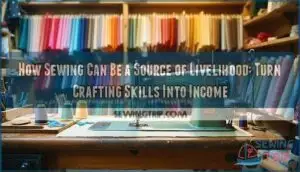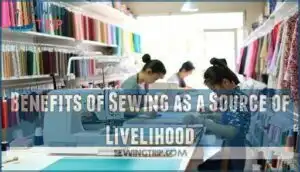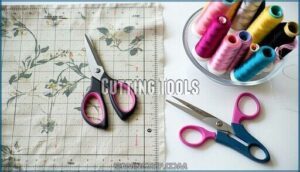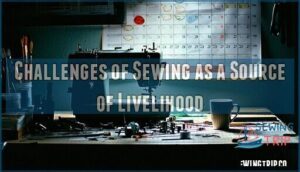This site is supported by our readers. We may earn a commission, at no cost to you, if you purchase through links.
 Sewing can be a reliable source of livelihood by transforming your skills into services or products people need.
Sewing can be a reliable source of livelihood by transforming your skills into services or products people need.
You can offer tailoring, alterations, or repairs to help others keep their favorite clothes in top shape.
Custom sewing, like creating unique outfits or home décor items, lets you tap into niche markets.
With quality tools like a sturdy sewing machine, sharp scissors, and precise measuring tools, you’re set to deliver professional results.
Finding customers involves building trust, using word-of-mouth, or marketing online.
Pricing fairly while covering costs is key to success in this craft, which has endless possibilities—ready to stitch your way to success?
Table Of Contents
- Key Takeaways
- Benefits of Sewing as a Source of Livelihood
- Skills Required for Sewing as a Career
- Types of Sewing Businesses
- Tools and Equipment Needed for Sewing Business
- How to Find Customers for Sewing Business
- Pricing Strategies for Sewing Business
- Challenges of Sewing as a Source of Livelihood
- Tips for Starting a Successful Sewing Business
- Frequently Asked Questions (FAQs)
- Conclusion
Key Takeaways
- Turn your sewing skills into income by offering services like alterations, custom clothing, or repairs while targeting niche markets.
- Invest in reliable tools like sewing machines, cutting tools, and measuring equipment to deliver professional results and streamline efficiency.
- Build your customer base through word-of-mouth, social media marketing, and local events while focusing on quality and consistency to retain clients.
- Manage costs by calculating material, labor, and overhead expenses, then set competitive prices with a clear profit margin to ensure sustainability.
Benefits of Sewing as a Source of Livelihood
Sewing offers you a pathway to financial independence through a skill that combines practicality with creative expression.
A creative skill like sewing opens doors to financial freedom while blending artistry with everyday practicality.
You’ll develop marketable abilities while enjoying a flexible schedule that adapts to your life circumstances.
Beyond personal economic empowerment, your sewing skills can create community impact through producing essential items or teaching others.
This sustainable income source requires minimal startup costs compared to other businesses.
As you progress, you’ll experience continuous skill development in design, material knowledge, and business acumen.
Many successful sewers report that their livelihood brings both financial security and personal fulfillment through creating with their hands.
Mastering skills like hemming can lead to additional income streams.
Skills Required for Sewing as a Career
What technical skills do you need to transform your sewing hobby into a sustainable career? Technical proficiency forms the foundation of any sewing career path – you’ll need mastery in operating various machines, executing different stitches, and understanding fabric properties.
Design skills and patternmaking are equally essential, allowing you to create or modify designs according to client specifications. Machine maintenance knowledge helps prevent costly repairs and downtime.
Beyond the needle and thread, business acumen matters substantially. You’ll need basic accounting, marketing, and customer service skills to attract and retain clients. Consider pursuing formal training through vocational schools or apprenticeships to become a seamstress properly.
Many successful professionals combine self-learning with structured education. Time management and problem-solving abilities are invaluable when handling multiple projects with tight deadlines.
Remember, the most successful sewing skills jobs require both technical expertise and soft skills to build lasting client relationships.
Types of Sewing Businesses
You can turn your sewing skills into a profitable business by focusing on areas like tailoring, alterations, or custom sewing.
Each option lets you meet specific customer needs while building a steady source of income.
Tailoring
Now that you understand the skills needed, let’s look at tailoring as a profitable business avenue.
Custom apparel design offers endless creative opportunities while generating steady income. You can specialize in custom suits, wedding attire, or formal wear tailoring.
Successful tailoring businesses require strong garment construction knowledge, pattern making skills, and smart textile selection. Many tailors find their niche in specialized services like corsetry or lingerie design.
The fashion design elements of tailoring allow you to express your artistic vision while meeting clients’ needs. When starting your tailoring business, focus on quality workmanship and building a portfolio that showcases your unique style and technical precision.
Alterations and Repairs
Beyond tailoring, alterations and repairs offer a profitable path in the sewing industry.
While fixing zippers or performing button repair might seem simple, these services fulfill essential customer needs.
Starting a sewing alterations business requires minimal investment but delivers steady income.
Customers constantly need:
- Garment reconstruction for changing sizes
- Invisible mending for damaged clothing
- Textile restoration for beloved but worn items.
Many professionals charge by the hour, with rates varying based on complexity.
Zipper replacements typically cost less than extensive tailoring services.
Building a reputation for quality sewing services creates loyal clients who return regularly and recommend your work to others, providing a steady income and helping to establish a reputation.
Custom Sewing
While alterations give old garments new life, custom sewing lets you create something entirely from scratch. You’ll work directly with clients to bring their unique visions to life—whether it’s wedding dresses, Halloween costumes, or small leather goods.
Custom sewing businesses thrive when you identify your niche market. You might specialize in custom design for formal wear or focus on sewing for profit through commission-based projects. Many successful entrepreneurs build their sewing income ideas around solving specific client needs.
For example, some sewists find success creating custom blackout curtains for clients seeking light control and style. To start your custom sewing services as a livelihood, consider the following steps:
- Build a portfolio showcasing your unique creations
- Set up an online presence to attract clients
- Price your work based on materials, time, and expertise
- Learn to balance creativity with practical business skills
Sewing innovation happens when you combine technical skills with your personal style. Your ability to create one-of-a-kind pieces is what’ll set your business apart, allowing you to offer unique visions and build a successful sewing income.
Tools and Equipment Needed for Sewing Business
You’ll need reliable tools to establish a profitable sewing business, including quality machines, sharp cutting implements, and precise measuring equipment.
Your investment in these essential items will determine the efficiency of your workflow and the professional quality of your finished products.
Sewing Machines
Moving from types of sewing businesses to the equipment that powers them, sewing machines are the heart of your operation. The right machine can make or break your sewing business livelihood.
Here are 5 key considerations for your sewing machine investment:
- Choose machines that match your specific business needs
- Position your machine at proper height with ample table space
- Consider an overlock machine for professional seam finishes
- Learn basic Machine Maintenance to extend equipment life
- Explore vocational training options for machine operation skills
Regular maintenance prevents costly repairs and downtime.
Consider exploring different sewing machine products to diversify your capabilities.
The Historical Evolution of sewing machines has led to Ergonomic Design improvements that reduce fatigue during long sewing sessions.
Cutting Tools
Cutting tools are the backbone of sewing, ensuring precision and ease when working with fabrics. Start with quality scissors suited to your needs—fabric shears for clean cuts, embroidery scissors for detail work, and pinking shears to prevent fraying.
Rotary cutters paired with a cutting mat are lifesavers for slicing through multiple fabric layers quickly. Don’t forget a seam ripper—it’s your go-to for fixing mistakes without damaging the material.
Keep your tools sharp and well-maintained; dull blades can ruin fabrics and slow you down. To find the best options, consider exploring a website that offers a variety of fabric shear products.
Here’s a quick guide:
| Tool | Best Use | Maintenance Tip |
|---|---|---|
| Fabric Shears | Cutting fabric | Sharpen regularly |
| Rotary Cutter | Multi-layer cuts | Replace blades often |
| Pinking Shears | Fray prevention | Clean after every use |
| Embroidery Scissors | Fine details | Store in a safe pouch |
| Seam Ripper | Stitch corrections | Check for sharpness |
Investing in reliable cutting tools boosts efficiency and elevates the quality of your sewing projects, turning your livelihood into a thriving craft with quality scissors and the right maintenance.
Measuring Tools
After cutting tools, accurate measuring tools are the backbone of sewing.
A tape measure is your go-to for flexible measurements, while a sturdy yardstick guarantees straight, precise lines.
For hems, a seam gauge is a lifesaver, keeping lengths consistent.
Rulers, especially quilting or curved French ones, offer versatility for marking fabric or shaping curves.
Want modern precision? Digital measuring tools streamline accuracy.
Consider purchasing a sewing tape measure for accurate measurements.
These tools prevent costly mistakes and wasted material, boosting your income generation potential.
Mastering their use refines your sewing skills and also builds trust with clients, paving the way for economic independence through quality craftsmanship.
How to Find Customers for Sewing Business
Finding customers for your sewing business starts with showcasing your work and reaching out to your community.
Showcase your creativity and connect with your community to turn your sewing passion into a thriving business.
Use social media, word-of-mouth, and local events to connect with people who need your skills.
Marketing Strategies
After gathering your tools, it’s time to focus on marketing your sewing business. Start by building an online presence through social media platforms like Instagram and Pinterest.
Share photos of your work to attract your target audience. Engage followers with behind-the-scenes posts or sewing tips, making your brand relatable.
Attend local fairs to showcase your skills and hand out business cards. Use Google My Business to appear in local searches, like “sewing services near me.”
Strong customer relations and consistent communication help foster customer loyalty, turning one-time clients into repeat customers who spread the word about your services. To effectively reach potential clients, consider how to define your audience, and build a strategy to improve your online presence and increase customer loyalty.
Building a Client Base
Building a solid client base for your sewing business means blending creativity with strategy.
Focus on:
- Client Referrals: Offer discounts for recommendations.
- Online Presence: Showcase your work on Instagram or Facebook.
- Local Partnerships: Collaborate with boutiques or tailors.
- Networking Events: Attend fairs to connect with potential customers.
- Customer Retention: Guarantee quality service to keep clients returning.
Strong customer relations fuel growth!
Pricing Strategies for Sewing Business
Setting the right prices for your sewing services guarantees you cover costs while staying competitive.
You’ll need to balance materials, time, and market rates to keep your business profitable and appealing.
Determining Costs
Understanding costs is the backbone of pricing strategies.
Break it down: track Material Costs (fabrics, threads), Labor Costs (your time or staff wages), and Overhead Expenses (rent, utilities).
Use cost-effective materials by sourcing from wholesale suppliers or seeking bulk discounts.
Compare pricing models to stay competitive while protecting profit margins.
Here’s a quick guide:
Calculate smartly to avoid sewing away your profits!
Setting Prices
After calculating your costs, it’s time to focus on pricing strategies that balance affordability and profitability.
Start with a solid cost calculation, then research competitors through market analysis to set competitive rates.
Always consider value perception—customers will pay more for quality and uniqueness.
Add a reasonable profit margin to guarantee sustainable income.
For profitable services, try the 2.5 ratio method: multiply material and labor costs by 2.5.
Remember, pricing isn’t static; adjust based on demand, trends, and customer feedback to keep your sewing business thriving.
Challenges of Sewing as a Source of Livelihood
Starting a sewing business comes with its own set of challenges, like managing time effectively and dealing with stiff competition.
You’ll also need to navigate seasonal demand, which can impact your income throughout the year.
Competition
Standing out in a crowded sewing market requires a smart approach.
Market saturation can feel overwhelming, but focusing on niche specialization helps.
Offer unique, profitable services like custom embroidery or repairs to attract specific customers.
Competitive pricing is important—research rates, but don’t undervalue your work.
A strong differentiation strategy, like using eco-friendly materials, sets you apart.
Build customer loyalty by delivering consistent quality and personalized service.
Remember, competition isn’t a threat—it’s a chance to sharpen your sewing business and thrive.
With the right mindset and strategies, such as strong differentiation, you can succeed.
Time Management
Managing time effectively is a game-changer for your sewing business and livelihood.
While competition keeps you sharp, time management guarantees you stay productive and avoid burnout.
Strong prioritization skills and deadline management are your best friends when juggling multiple projects.
Use scheduling techniques like daily planners or apps to organize tasks and track progress.
It’s like stitching a pattern—every step matters.
Workflow optimization can save hours, so streamline repetitive tasks with efficiency boosters like pre-cutting fabric or batching similar jobs.
Here’s how to stay on top of freelance sewing work:
- Focus on tasks that directly help you earn money sewing.
- Set realistic deadlines to balance quality and speed.
- Avoid overloading your plate; know when to say no.
Smart planning keeps you stitching ahead with strong prioritization skills and deadline management, ensuring you remain productive and avoid burnout by using scheduling techniques and optimizing your workflow.
Seasonal Demand
Seasonal demand can make or break your sewing business, so it’s smart to plan ahead. Think about holiday sewing, wedding seasons, school uniforms, and even fashion trends tied to weather changes.
Stock up on essential materials before peak times, and use marketing to highlight your services when demand surges. Understanding fabric content can help you choose the right materials for each season’s projects.
| Season | High Demand Items | Marketing Focus |
|---|---|---|
| Holidays | Custom gifts, decorations | Promotions, gift ideas |
| Wedding Season | Dresses, alterations | Bridal packages, referrals |
| Back-to-School | Uniforms, backpacks | Early-bird discounts |
Keep pricing strategies flexible and guarantee quality control. A reliable supply chain helps you meet tight deadlines without overstocking. With preparation, seasonal shifts can boost your livelihood!
Tips for Starting a Successful Sewing Business
If you’re ready to turn sewing into a livelihood, starting strong is key.
After overcoming challenges like competition and seasonal demand, it’s time to focus on building a thriving sewing business.
Begin by selecting a niche that matches your skills and interests—whether it’s alterations, custom clothing, or embroidery.
This helps you stand out in a crowded market.
Build a portfolio showcasing your best work to attract clients and highlight your expertise.
Use competitive pricing to balance affordability with profit.
Research local rates and factor in costs like materials and time.
Leverage social media to market your sewing business.
Post photos of your creations, share customer reviews, and engage with followers.
Frequently Asked Questions (FAQs)
Can sewing be a profitable income source?
Stitching skills spark success, offering endless opportunities.
From crafting custom clothes to repairing garments or teaching others, sewing can be a profitable venture.
Focus on quality, niche markets, and smart pricing to thrive financially.
How can I monetize my sewing skills?
Sell custom clothing, offer alterations, or create personalized items like embroidered gifts.
Launch online tutorials or DIY kits.
Build a portfolio, price competitively, and market through social media to attract and retain customers, focusing on personalized items.
How does a Livelihood Centre work?
A livelihood center equips people with tools, training, and opportunities to build sustainable income.
You’ll learn essential skills, access resources like sewing machines, and connect with mentors, fostering community, self-reliance, and economic growth through shared efforts.
How do you become a successful sewing entrepreneur?
Focus on building your skills, find a unique niche, and create a portfolio showcasing your work.
Research market trends, set competitive prices, and use social media to connect with customers and grow your audience, focusing on building your skills to create a portfolio.
What is sustainable progress in sewing business?
Sustainable progress in sewing means balancing quality, creativity, and eco-friendly practices.
Use durable materials, minimize waste, and continuously upgrade your skills.
Build strong customer relationships and adapt to trends while staying true to your unique style.
Can sewing make a full-time income?
Yes, sewing can provide a full-time income if you diversify services like custom clothing, alterations, and embroidery.
Build a strong portfolio, price competitively, and use social media to connect with customers and grow your business.
Why is sewing important in our lives?
Imagine mending a torn shirt instead of tossing it—sewing saves money, reduces waste, and sharpens creativity.
It connects you to tradition, fosters self-reliance, and empowers you to transform simple materials into something remarkable.
How does sewing help the environment?
Sewing helps the environment by reducing waste through repairing clothes, reusing old fabrics, and creating durable items.
By opting for handmade goods, you cut reliance on mass production, which often leads to pollution and overconsumption.
Why are sewing skills a valuable resource?
To put it bluntly, sewing’s a game-changer.
It equips you with practical skills to create, repair, or customize textiles, fostering independence.
Plus, it opens doors to income, creativity, and building connections in any community, making it a valuable skill that promotes independence.
How did the sewing machine improve people’s lives?
The sewing machine transformed lives by speeding up clothing production, reducing manual labor, and creating economic opportunities.
It enabled you to produce garments efficiently, pursue creative projects, and even launch small businesses with minimal resources, which helped to further emphasize the impact of the sewing machine in transforming lives.
Conclusion
Picture a single thread weaving opportunities into your life—this is how sewing can be a source of livelihood.
By honing your skills, investing in quality tools, and understanding your market, you can transform a timeless craft into a steady income.
Whether offering alterations, tailoring, or creating custom pieces, the key lies in building trust, pricing wisely, and staying consistent.
Sewing isn’t just a hobby; it’s a pathway to financial independence, stitched together one project at a time.
- https://www.csmonitor.com/World/Making-a-difference/2021/0603/Sew-it-goes-The-Sewing-Machine-Project-stitches-lives-back-together
- https://thesewingmachineproject.org/
- https://mailchi.mp/f754049c8ed0/check-out-our-spring-2021-newsletter-4728473
- https://campaigns.worldvision.org.ph/become-a-partner/
- https://www.facebook.com/worldvisionph


















